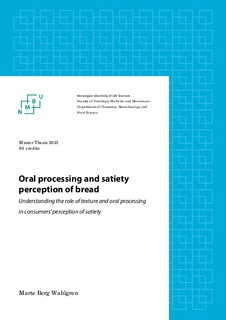| dc.description.abstract | The worldwide prevalence of obesity doubled between 1980 and 2014. This rise lends great interests to preventive measurement aimed at satiety enhancement, as healthy products of enhanced satiety potentially could encourage responsible consumption. The objective of this Master thesis was to understand the role of texture and oral processing of bread in consumers’perception of satiety. Eight iso-caloric breads were manufactured, using the same procedure and ingredients but manipulating texture by changing process parameters. A trained sensory panel evaluated the eight samples focusing on dynamic perception of texture, using the sensory method Temporal Dominance of Sensations (TDS). Based on the results, four samples with well-differentiated dynamic texture profiles were selected. The sensory panel analyzed the four chosen samples using Quantitative Descriptive Analysis (QDA) in order to obtain a complete sensory description of the breads. A consumer test was performed where consumers evaluated their overall liking, expected satiation and expected satiety for the four samples. They answered to a check-all-that-apply (CATA) question as well, for both real samples and for their ideal bread, to provide sensory and usage profiles for the products.The results showed that texture during oral processing was not static and attributes evolved during mastication, where different attributes were dominant at different stages. Texture attributes related to a more demanding processing before the bolus was ready to swallow,seemed to describe the breads expected to be the most satiating. These texture attributes caused changes in oral processing time, which has been shown to influence satiety; however,this does not seem to be the only factor influencing expected satiety. Many factors might influence the food intake during an eating event, and from this study, it is clear that texture during oral processing is a contributing factor, and that the sequence and dominance of texture
attributes perceived during oral processing are of importance in satiety perception. | nb_NO |
